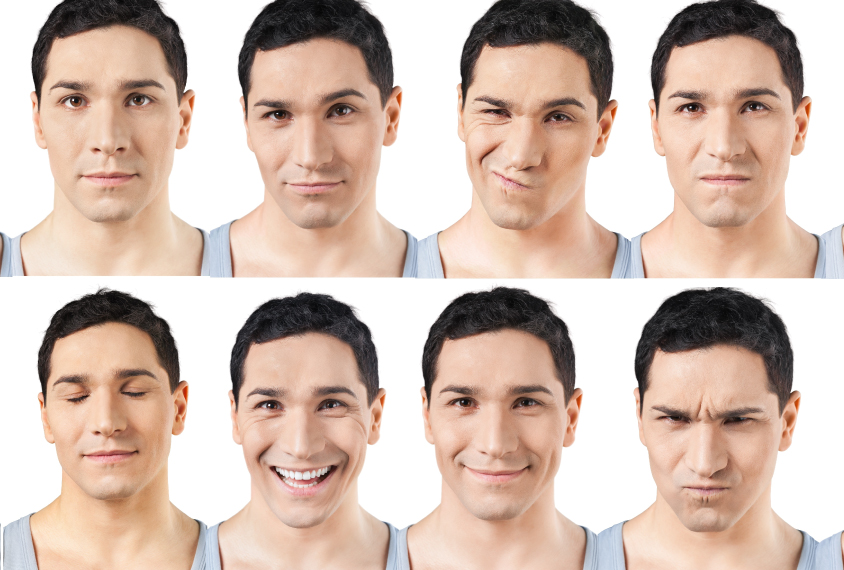
People with autism sometimes give ambiguous looks
Autistic people have trouble making facial expressions appropriate to the circumstances.
Facial expressions smooth social interactions: A smile may show interest, a frown empathy. People with autism have difficulty making appropriate facial expressions at the right times, according to an analysis of 39 studies1. Instead, they may remain expressionless or produce looks that are difficult to interpret.
The new work is the largest yet to explore this issue. Such studies are rare relative to those focused on autistic people’s difficulty interpreting others’ expressions.
Producing suitable expressions is likely to be just as important to social interaction as reading others’ faces, says lead researcher Elina Birmingham, associate professor of education at Simon Fraser University in Burnaby, Canada. “Face-to-face interactions are a two-way street,” she says.
Birmingham’s study suggests that autistic people have more trouble making spontaneous expressions than more intentional ones, hinting that studying this in artificial situations may not fully recapitulate the problem.
New technologies could help researchers measure expressions in real-life social situations. In a separate study published in November, a group of researchers showed that a new computer program can accurately evaluate facial expressions in children with autism2.
Strange looks:
Birmingham and her colleagues analyzed studies published from 1981 to 2017, involving a total of 684 autistic individuals and 674 controls. The studies vary in the ways they conceptualize and measure facial expressions, says Dominic Trevisan, now a postdoctoral fellow in James McPartland’s lab at Yale University.
To deal with the variability, the team sorted the studies into seven categories according to the aspect of facial expression measured — such as how long a smile lasts or how big it is.
The analysis supports the view that people with autism are less expressive than controls. They make expressions less often and fleetingly; they are also less likely to unconsciously mimic others’ looks or to use their expressions to smooth social interactions. What’s more, others are relatively likely to judge the facial expressions they do make as odd or difficult to interpret.
However, people with autism produce smiles and frowns of similar intensity and size to those of controls, and they also make grimaces and other expressions equally quickly in response to stimuli such as strong odors. The work appeared in the December issue of Autism Research.
Lack of spontaneity:
The older the autistic participants in a study, the smaller the differences between them and controls. The differences are also smaller when they have an intelligence quotient (IQ) in the normal range rather than one that is low.
“With increasing age and higher intellectual functioning, people with autism may develop compensatory strategies for producing facial expressions that are more typical,” Birmingham says.
Researchers should match participants for age and IQ to determine whether autistic people’s expressions really are different from those of controls, says Rebecca Shaffer, assistant professor of pediatrics at Cincinnati Children’s Hospital in Ohio, who was not involved in the work.
The differences are greatest for spontaneous expressions, rather than those that participants are prompted to make.
“The [team] did a really nice job of teasing apart elicited versus spontaneous facial expressions, which is definitely a strength and not something that I have seen as clearly differentiated in the past,” Shaffer says.
The results illustrate why it is difficult to study production of facial expressions and determine what makes them effective as communication tools.
“It’s the nuances that make [facial expression] production that much more subtle,” says Jim Tanaka, professor of psychology at the University of Victoria in British Columbia, who was not involved in the work. “I think that gets to the crux of the challenges of people on the spectrum.”
Smile software:
Facial expressions are difficult to measure objectively. One new strategy uses machine learning to train a computer to recognize key muscle movements involved in facial expressions. The system is more accurate than autism experts at analyzing facial expressions in children with autism. For example, it can assess whether an expression clearly conveys the intended emotion. The findings were published 16 November in Sensors.
“A human being is limited in detecting infinitesimal movements — especially of the upper part of the face,” says lead researcher Marco Leo, a researcher at the National Research Council of Italy in Lecce.
Automated systems can be finicky, however, requiring participants to sit directly in front of a camera and stay still. “It’s sort of a tradeoff between experimental control and realistic social behavior,” Trevisan says.
A setup with multiple cameras could help address this problem, Leo says, eventually enabling objective analysis of real-life social interactions.
Birmingham is investigating whether people with autism are more expressive when talking about a special interest or a favorite toy. If so, she says, there may be ways to use that interest to improve their facial expressions in other circumstances.
References:
Recommended reading

Developmental delay patterns differ with diagnosis; and more

Split gene therapy delivers promise in mice modeling Dravet syndrome

Changes in autism scores across childhood differ between girls and boys
Explore more from The Transmitter

‘Natural Neuroscience: Toward a Systems Neuroscience of Natural Behaviors,’ an excerpt

